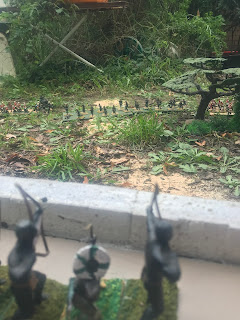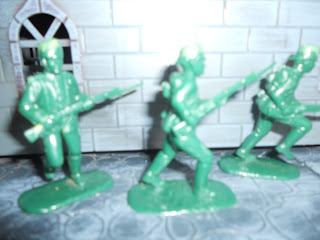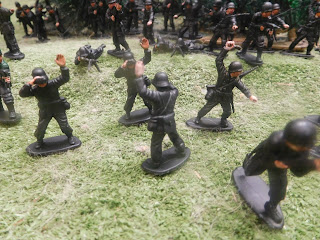Experiments In Molding With Glycerin And Gelatin
I have been looking at Internet videos on how to make molds from glycerin and gelatin. lately I have bit the bullet and tried it. I had mixed results but I'm getting the hang of it.
The basic process is to mix 2 parts of glycerin to 2 parts of gelatin to 1 part water and heating them up together in the microwave oven, long enough to melt the gelatin crystals. I was able to obtain the gelatin crystals from the supermarket and ordered the glycerin on-line.
Prior to that I took a desired toy soldier and Blue tacked it to the inside base of a plastic or paper cup or cut down drink bottle. The best ones are Mac Donalds cups. You can probably also buy plastic or paper cups meant for parties and such. I prefer to use ones I find lying around and give them a wash or get them from my daughter when she indulges herself in takeaways. These are the very flexible containers, easy to cut.
When the mix has been stirred and cooled a little in the fridge - to avoid causing any damage, however unlikely especially to older plastic figures - pour it into the cup and cover the head a good, few centimeters. Leave it for about 12 hours.
With a craft or craft knife or scalpel carefully cut down the sides of the plastic cup. I leave enough uncut so I can put the mold back in the cup. Remove the mold. Then, also carefully, cut along each side and up to the figure. You can choose to cut along the top and up to the head or reverse and cut along the base. If you do the former the mold might not fit as snuggly back in the cup. The aim is not to cut the mold completely in half so it will hold together better. Partially separate the mold so you can make a pour hole over the center of the preferred top. It should be like a funnel shape. I am also experimenting with making one or two additional passages to allow air to escape.
The mold itself you will find is like flexible an edible jelly but surprisingly firmer and much less wobbly. It has the color of a dark honey. It is actually edible and a little sweet from the glycerin, although I wouldn't try to eat a whole one. I looked this up and for curiosity tied a smidgen! Eating a lot of it can, apparently, cause stomach upsets. However, it is not poisonous, and your dog or cat might also be interested in eating your molds so mind where you put them. Once you have remnants of resin in the mold it is no longer safe to eat. In any case the molds, with their rich honey or dark beer colors look quite enticing!
Now, removing the figure: This should be done slowly and gradually, especially if you used an old brittle plastic Timpo or similar! You have to decide if you want to take that calculated risk to produce a copy.
The drawback of this material is I assume that it would not work with molten metal and might even be dangerous to try. I guess that the material would melt or even disintegrate. You have to use resin. I bought a couple of gallons of the stuff recently which cost be over $90. The resin comes in two parts and needs to be mixed as required in exactly equal portions. I have been overestimating how much I need each time and so wasting some of it. The directions say you should wear latex gloves. The resin has a nasty sticky feel to it and it is hard to remove from hands. Obviously keep skin contact to a minimum and don't rub your eyes. I have to admit that so far, I haven't used the gloves as I find they interfere with my tactile senses and also, I don't like making more unrecyclable rubbish. (Incidentally, when we had to wear 'disposable' Covid face masks I used the same one for months although I gave it a wash now and then).
Put some tape around the mold and put it snuggly back in the cup. You can also tape around the cup/container to hold it together. I use paper masking tape. After stirring well, the resin for a few minutes, pour it into the mold and make sure you fill to the top. You can give it a few taps as well. The resin takes 24 hours to fully set but I have found I can remove it, carefully, after 12 hours but it will still be a bit soft. if the casting doesn't want to easily come out wait another 12 hours.
If you do take it out at the halfway mark you will find that you can pull off much of the flash.
So far using resin in Siligum molds I have found that often it leaks out and I lose a fair amount of resin. maybe I needed to make the molds better, but I had less of this issue with the gelatin molds. One reason is the mold is still connected at one end. The other is there is a lot of the material around the casting and another is that the cup holds the mold snugly together.
However, a number of my early efforts resulted in headless figures, probably because the heads were not deep enough in the molds and to close to the pour hole. I can still use these figures for conversions. Also, the resin was sometimes too soft, probably because the mix was either not stir enough or was a little low in the hardener portion. The particular resin I am using is not a very hard, potentially brittle one but much softer and sets transparent. In fact, the figures look like ethereal ghosts! They could even be left unpainted like that to represent spirits! In any case I am getting better at the casting and the figures themselves have much better detail than my lead and pewter castings.
I thought, from my internet reading, that the molds would be good for only one casting but so far, I have made two figures from a mold and the gelatin and glycerin mold is still intact. The other thing is you can just melt the old down and make a new one and you can keep doing so! I haven't noticed the material deteriorate from being left out but it can be put in the fridge for safe-keeping.
This is one of the cheapest mold materials and I have found it relatively successful. I'll keep you posted as to how many castings I can get out of one mold. It is good for when you want to make a duplicate of a rare item and I am also going to try it with spare weapons. I also want to make multiple figures to flesh out units.
I am still waiting for my camera to arrive so there are no photos of the molds, as yet. But I attach some pics of Timpo figures I'd like to do castings of but have so far been reluctant. Quite possibly, a Timpo figure would have to be a sacrificial lamb as I imagine some extremities could well snap off in the extraction process. But once the mold is done then a number of copies can be made and painted, either in the style of the originals or in much more detail. You might also sculpt or convert new figures that would benefit from making multiples.











Sounds interesting to mold your own miniatures. I'm looking forward to follow you project and results. To how small scale do you think it will be possible to mold OK figures using this method? 1:72 and 1:87??
ReplyDeleteSo far I have tried only 1/32 but I don't see why smaller scales would not work.
ReplyDeleteWhen resin casting, I keep an open face dump mold handy. Say a mold for a crater, or boxes. One piece mold open on top. Dump any extra resin into the dump mold. It make take the surplus from several castings to fill the crater or boxes, but resin usually sticks to itself and you get a few free bits. Great read, good ideas.
ReplyDeleteThat is an excellent idea, one I have been already thinking of doing! Also, some equipment, such as arrow quivers can be flat on one side.
ReplyDelete